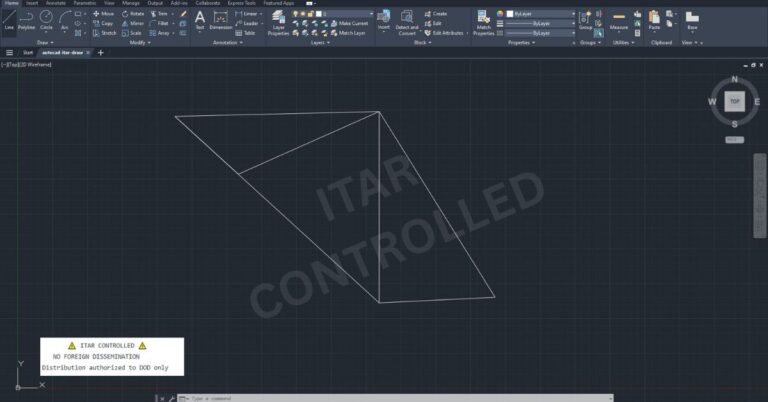Is AutoCAD ITAR Compliant? A Comprehensive Guide for Defense Manufacturers
Defense contractors and manufacturers working with sensitive military technologies face a critical question when selecting computer-aided design software: Is AutoCAD ITAR compliant? This question becomes increasingly important as companies pursue government contracts and handle controlled technical data that falls under the International Traffic in Arms Regulations.
The short answer is nuanced. While AutoCAD itself is not explicitly certified as ITAR compliant out of the box, it can be configured and implemented within an ITAR-compliant framework through proper security controls, procedural safeguards, and organizational policies. Understanding this distinction is crucial for defense manufacturers who rely on CAD software for their daily operations.
Understanding ITAR and Its Impact on CAD Software
The International Traffic in Arms Regulations represent a comprehensive set of United States government regulations that control the export, import, and transfer of defense-related articles, services, and technical data. Administered by the State Department’s Directorate of Defense Trade Controls, ITAR ensures that sensitive military technologies remain secure and are only shared with authorized parties.
For CAD software users, ITAR compliance isn’t about the software itself being certified, but rather about how the software is deployed, configured, and used within an organization’s security framework. The regulations focus on protecting the technical data created, stored, and transmitted using these tools rather than certifying the tools themselves.
When defense contractors ask whether AutoCAD ITAR compliant solutions exist, they’re really asking about implementing comprehensive security measures around their CAD environment to meet regulatory requirements.
While this article focuses on AutoCAD, it’s important to note that ITAR compliance and data security requirements apply equally to all CAD applications—including CATIA, Creo, Siemens I-DEAS, SolidWorks, Autodesk Inventor, Blender, Fusion 360, and others.
AutoCAD's Role in Defense Manufacturing
AutoCAD has established itself as a fundamental tool across multiple manufacturing sectors, with particularly strong adoption in defense-related industries. The software’s versatility makes it valuable for various applications within defense manufacturing environments.
Aerospace and defense manufacturers rely heavily on AutoCAD for creating detailed technical drawings, assembly instructions, and manufacturing documentation. These companies use the software to design everything from aircraft components to ground vehicle systems, often handling technical data that falls directly under ITAR regulations.
Automotive manufacturers working on defense contracts use AutoCAD for vehicle modifications, armor integration, and specialized equipment installations. The software’s precision and documentation capabilities make it ideal for creating the detailed drawings required for government approval processes.
Electronics manufacturers producing defense-related components utilize AutoCAD for circuit board layouts, enclosure designs, and system integration drawings. These technical drawings often contain sensitive information about capabilities and specifications that require ITAR protection.
Shipbuilding and naval contractors depend on AutoCAD for hull designs, system layouts, and modification drawings. Given the sensitive nature of naval vessel specifications, ensuring AutoCAD ITAR compliant operations becomes critical for these manufacturers.
Current AutoCAD ITAR Compliance Status
Autodesk, the company behind AutoCAD, does not provide explicit ITAR certification for their software products. Instead, they direct customers to request compliance information through their Trust Center and recommend consulting with ITAR specialists for configuration guidance.
This approach reflects the reality that ITAR compliance is less about software certification and more about implementation methodology. The responsibility for achieving and maintaining compliance rests with the organization using the software, not with the software vendor.
Autodesk does maintain various security certifications and undergoes regular audits for their cloud-based services, but these focus on data security rather than ITAR-specific requirements. Companies requiring AutoCAD ITAR compliant solutions must implement additional controls and procedures beyond what the software provides by default.
Essential Requirements for AutoCAD ITAR Compliance
Creating an AutoCAD ITAR compliant environment requires addressing multiple layers of security and operational controls. These requirements extend far beyond the software itself and encompass the entire ecosystem in which the CAD system operates.
Access control represents the foundation of any AutoCAD ITAR compliant implementation. Organizations must implement robust user authentication systems, typically involving multi-factor authentication and role-based access controls. Every user accessing the CAD system must be properly vetted and authorized to handle controlled technical data.
Data classification and marking procedures ensure that all technical drawings and related files are properly identified according to their sensitivity level. AutoCAD ITAR compliant operations require clear labeling of all defense-related technical data and implementation of automated marking systems where possible.
Network security measures must isolate CAD workstations from unauthorized access while maintaining necessary connectivity for legitimate business operations. This often involves creating segmented networks, implementing firewalls, and monitoring all data transfers.
Physical security controls protect the hardware and storage media containing sensitive CAD data. AutoCAD ITAR compliant facilities require restricted access to CAD workstations, secure storage for backup media, and proper disposal procedures for hardware containing sensitive data.
Export control procedures prevent unauthorized transfer of technical data outside the United States or to foreign nationals. These procedures must be integrated into the CAD workflow to prevent accidental violations during normal operations.

Implementation Steps for AutoCAD ITAR Compliance
Achieving AutoCAD ITAR compliant operations requires a systematic approach that addresses technical, procedural, and organizational aspects of CAD system management.
The first step involves conducting a comprehensive assessment of current CAD operations to identify gaps between existing practices and ITAR requirements. This assessment should examine user access controls, data handling procedures, network security, and existing compliance measures.
Configuration of AutoCAD network and system security settings forms the technical foundation of compliance efforts. This includes disabling cloud connectivity features, configuring secure file sharing options, and implementing appropriate backup and recovery procedures. Organizations must also establish secure methods for software updates and patch management that don’t compromise sensitive data.
Development of standard operating procedures ensures consistent compliance across all CAD operations. These procedures must address file creation, modification, sharing, and archival processes while maintaining clear audit trails for all activities involving controlled technical data.
Staff training programs educate all CAD users about ITAR requirements and their responsibilities when handling sensitive technical data. Training must be ongoing and include regular updates about regulatory changes and best practices.
Regular compliance monitoring through audits and assessments helps maintain AutoCAD ITAR compliant operations over time. These reviews should examine both technical controls and procedural compliance to identify areas for improvement.
Manufacturing Sectors Requiring AutoCAD ITAR Compliance
Different types of manufacturers face varying levels of ITAR compliance requirements when using AutoCAD, depending on their involvement with defense-related projects and the sensitivity of their technical data.
Prime defense contractors working directly with the U.S. Department of Defense represent the highest level of ITAR compliance requirements. These organizations typically handle the most sensitive technical data and face the strictest regulatory oversight. Their AutoCAD ITAR compliant implementations must meet the most rigorous security standards and undergo regular government audits.
Subcontractors and suppliers to defense primes also require AutoCAD ITAR compliant operations when handling controlled technical data. While their compliance requirements may be less extensive than prime contractors, they still must implement appropriate safeguards to protect sensitive information shared with them.
Commercial manufacturers pursuing defense contracts need to establish AutoCAD ITAR compliant capabilities before they can participate in certain government procurements. This often represents a significant investment in new procedures and security measures for companies transitioning from purely commercial operations.
Research and development organizations working on defense-related technologies require specialized AutoCAD ITAR compliant configurations to protect intellectual property and prevent unauthorized technology transfer. These organizations often face unique challenges related to academic collaboration and international research partnerships.
Common Challenges in AutoCAD ITAR Compliance Implementation
Organizations pursuing AutoCAD ITAR compliant operations frequently encounter several recurring challenges that can complicate implementation efforts.
Integration with existing systems often proves more complex than anticipated, particularly for organizations with established CAD workflows and legacy systems. Balancing security requirements with operational efficiency requires careful planning and often involves trade-offs between convenience and compliance.
Staff resistance to new procedures can slow implementation and create compliance risks. Users accustomed to unrestricted CAD operations may find ITAR-compliant workflows cumbersome, necessitating comprehensive change management efforts.
Maintaining compliance over time requires ongoing vigilance and resources. As projects evolve and staff changes occur, organizations must continuously monitor and update their AutoCAD ITAR compliant procedures to prevent compliance drift.
Cost considerations can be significant, particularly for smaller organizations or those new to defense contracting. Implementing comprehensive ITAR compliance measures requires investment in technology, training, and ongoing support that may strain limited resources.
Technology Solutions Supporting AutoCAD ITAR Compliance
Several technology solutions can enhance AutoCAD ITAR compliant operations by providing additional security layers and compliance automation capabilities.
Data loss prevention systems monitor file transfers and prevent unauthorized sharing of sensitive CAD data. These systems can be configured to recognize AutoCAD files and apply appropriate controls based on file content and classification.
Secure collaboration platforms enable AutoCAD ITAR compliant file sharing with authorized parties while maintaining detailed audit trails of all access and modification activities. These platforms often include version control and approval workflow capabilities.
Identity and access management systems streamline user authentication and authorization processes while ensuring that only properly cleared personnel can access sensitive CAD data. Integration with existing directory services simplifies administration and reduces security gaps.
Backup and disaster recovery solutions specifically designed for sensitive data environments ensure that AutoCAD ITAR compliant operations can continue during system failures or security incidents without compromising data protection requirements.
Best Practices for Maintaining AutoCAD ITAR Compliance
Successful long-term AutoCAD ITAR compliant operations require adherence to established best practices that address both technical and procedural aspects of compliance management.
Regular security assessments help identify potential vulnerabilities before they become compliance violations. These assessments should examine both technical controls and user procedures to ensure comprehensive protection of sensitive data.
Continuous monitoring of user activities and system performance provides early warning of potential compliance issues. Automated monitoring tools can flag suspicious activities or policy violations for immediate investigation.
Documentation management ensures that all compliance-related procedures, training records, and audit results are properly maintained and readily available for regulatory reviews. Comprehensive documentation also supports continuous improvement efforts.
Incident response planning prepares organizations to respond quickly and effectively to potential ITAR violations or security breaches involving CAD data. Well-developed response plans minimize the impact of incidents and demonstrate due diligence to regulators.
Conclusion: Achieving AutoCAD ITAR Compliance
While AutoCAD is not inherently ITAR certified, defense manufacturers can absolutely achieve AutoCAD ITAR compliant operations through proper implementation of security controls, procedures, and organizational policies. Success requires a comprehensive approach that addresses technical configuration, user training, procedural compliance, and ongoing monitoring.
The investment required to establish AutoCAD ITAR compliant operations pays dividends through access to defense contracts, reduced regulatory risk, and enhanced security posture. Organizations that commit to comprehensive compliance implementation position themselves for long-term success in the defense contracting marketplace.
For defense manufacturers serious about achieving and maintaining AutoCAD ITAR compliant operations, professional guidance and support can significantly accelerate implementation while reducing compliance risks.
Ready to ensure your AutoCAD environment meets ITAR requirements? Contact Cleared Systems today to learn about our comprehensive AutoCAD ITAR Compliance Services. Our experienced team will assess your current operations, design a tailored compliance framework, and provide ongoing support to keep your organization compliant and competitive. Don’t let ITAR compliance challenges limit your defense contracting opportunities – let us help you implement robust, efficient AutoCAD ITAR compliant solutions that protect your sensitive data while supporting business growth.
Share in Social Media
See More Case Studies

Securing Defense Contracts: A DFARS 252.204-7012 Compliance Case Study
Discover how Cleared Systems helped a Federal Contractor successfully achieve DFARS 252.204-7012 compliance by strengthening its cybersecurity posture, giving it a competitive edge when bidding for DoD Contracts.

What is GCC High? For ITAR & CMMC 2.0
Microsoft 365 Government Community Cloud (GCC) High is a specialized cloud solution tailored for U.S. federal, state, local, tribal, and territorial government organizations, as well as for contractors who hold or process data subject to specific security regulations. In this article, we will explore the features, benefits, and differences between Microsoft 365 GCC High and other Office 365 offerings.

How to Get Help in Windows: Guide to Security and Compliance Support
In today’s digital landscape, ensuring your computer systems are secure and compliant with industry regulations is essential for both businesses and individuals. Windows, as one

Microsoft Copilot for GCC High: Enhancing Security and Compliance
In today’s fast-evolving digital landscape, organizations that handle sensitive data, particularly those in government sectors or defense contractors, face growing pressure to maintain strict security

ITAR Explained: Why It Matters for U.S. Companies
The International Traffic in Arms Regulations (ITAR) is a set of U.S. government regulations designed to control the export and import of defense-related articles and
Partner with Us for Compliance & Protection
We’re happy to answer any questions you may have and help you determine which of our services best fit your needs.
Your benefits:
- Client-oriented
- Security
- Compliance
- Peace of mind
- Efficiency
- Trust
What happens next?
Schedule an initial meeting
Arrange a discovery and assessment call
Tailor a proposal and solution
